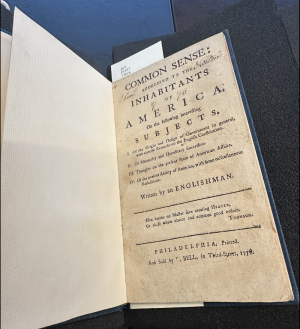"Common Sense", Early Edition - Thomas Paine
Backgroung
Introduction
"Common Sense" by Thomas Paine, published in January 1776, is arguably one of the most influential pamphlets in American history. Its vigorous argument for the American colonies' independence from Great Britain galvanized public opinion like no other work of the period. This entry explores "Common Sense" through a rare preserved example of a 1776 copy of Thomas Paine's "Common Sense", the impact it had on the American Revolution, and its lasting legacy in shaping democratic ideals.

Historical Context
"Common Sense," the pivotal pamphlet by Thomas Paine, emerged at a critical juncture in American history, becoming one of the most influential texts in the lead-up to the American Revolution. Its production and publication were timely, coinciding with a growing discontent among the American colonists towards British rule. Thomas Paine, an English-born American political activist and writer, arrived in Philadelphia in November 1774. He brought with him a background in radical and revolutionary ideas, having been influenced by the Enlightenment thinkers of his time. Paine was deeply troubled by the inequalities and injustices observed under British governance. By late 1775, amidst escalating tensions between Britain and its American colonies, Paine began writing "Common Sense."
The pamphlet was written in a span of just a few months. Paine's arguments were clear and persuasive, advocating for complete independence from Britain rather than mere reconciliation. He presented his case in a straightforward manner, appealing not only to the intellectuals but also to ordinary colonists, making the complex political theories accessible to the masses. "Common Sense" was published on January 10, 1776, by Robert Bell in Philadelphia. The timing was critical as it capitalized on the colonists’ rising frustration following the battles of Lexington and Concord and the ongoing siege of Boston. Paine's work argued compellingly that the time had come for the colonists to declare independence and establish their own government, a radical idea at the time.
The pamphlet sold over 100,000 copies in its first months, spreading like wildfire through the colonies and playing a significant role in shaping public opinion. "Common Sense" not only encouraged the common people of the American colonies to support the cause of independence but also influenced key decision-makers in the Continental Congress. As tensions escalated, Paine’s "Common Sense" continued to inspire and mobilize the colonists, setting the stage for the drafting of the Declaration of Independence in July 1776. The impact of Paine’s writing cannot be overstated; it provided the philosophical foundation that guided the revolutionary movement and altered the course of history.
Publication History and
"Common Sense" was published anonymously in Philadelphia under the alias "Englishman," a strategic decision by Paine due to the seditious nature of the text. The pamphlet’s impact was immediate and profound, selling over 100,000 copies in just 3 months, and amounting to around 500,000 by the end of the revolution, a staggering number for the period considering the right bearing population of the colonies at the time was around 2 million. Its affordability, at just two shillings, allowed it to spread widely and quickly among the colonies. The choice of Robert Bell as the publisher, a radical printer known for his willingness to take on controversial projects, was crucial in ensuring the pamphlet reached as many readers as possible. Bell's promotional strategies and the broad distribution of the pamphlet played a key role in its success and influence. But as "Common Sense" gained traction Paine and Bell's collaboration would be cut short due to friction between the two. Paine was disappointed after Bell informed him there were no profits (which he intended to donate to the independence movement). Feeling betrayed he immediately cut ties with R. Bell seeking other printers. R. Bell in an attempt to get back at Paine would start printing his own edited copy called, "Large Additions to Common Sense." As the controversy escalated, Bell's actions, driven by a mix of spite and commercial ambition, only served to fuel the public's interest in "Common Sense." His unauthorized edition, featuring additional materials not penned by Paine, aimed to capitalize on the pamphlet's burgeoning popularity. This edition, marketed as being substantially larger due to these "Large Additions," was Bell's attempt to outshine Bradford's authorized version and reclaim his stake in the pamphlet's success. However, Bell's efforts were undermined by Paine's decision not to copyright the work, granting freedom for it to be reprinted by anyone. This allowed for widespread dissemination beyond Bell's control, further democratizing the revolutionary ideas Paine espoused. Despite Bell's initial pivotal role in the distribution of "Common Sense," his relationship with Paine deteriorated irreparably, highlighting a tumultuous chapter in the history of American revolutionary literature. This public dispute not only kept "Common Sense" in the news, increasing its visibility, but also underscored the complexities of publishing in revolutionary times.